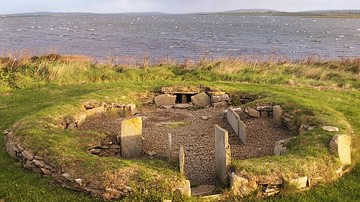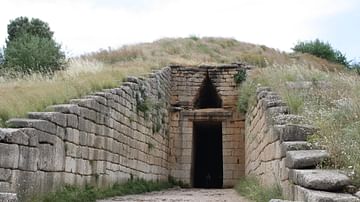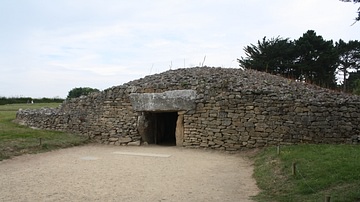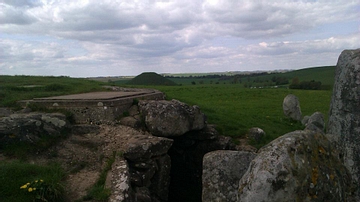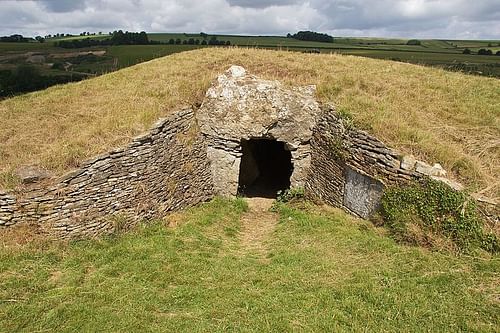
A Long Barrow is a class of Middle Neolithic (approximately 3500-2700 BCE) burial monument which is found extensively throughout the British Isles and is related to other forms of contemporary tomb-building traditions of north-western Europe, particularly that of northern France.
Essential Features
The essential features of a long barrow are:
- A long either rectangular or trapezoidal mound of soil and stone.
- Flanking ditches or pits, where the stone for the mound's construction would have come from.
- Chambers inside the mound built from either timber or orthostats (an upright stone that is used to form part of a structure).
- Some kind of elaboration at the higher and wider end of the mound in the form of either a concave forecourt or facade.
Much of the archaeological literature on this period distinguishes between earthen long barrows in the south and east of the British Isles, and the stone chambered tombs of the north and west. Both of these types are part of the wider architectural tradition on long barrow building, although it is worth pointing out that not all chambered tombs are long barrows.
The chambers within a long barrow are located in one of two areas. Firstly, the terminal chambers which open into the mound from the wider and higher end of the structure, from the back of the forecourt or facade. Secondly, the lateral chambers which open into the side of the mound. In all cases, the chambers represent a small proportion of the overall structure, which has prompted some critics to suggest that these barrows also functioned as territorial marks.
The burials inside these mounds are usually disarticulated inhumations of human remains, with the corpses having been placed in the entrance way first, and then bit by bit as the body decays get moved further and further back in the barrow, allowing for more room for the induction of new burials.
Regional Groups
All dated long barrows were built and used during the mid 4th millennium BCE. Many of these structures show signs of abandonment and in some cases deliberate blocking after 3000 BCE. There are a number of regional groupings that can be recognised as being long barrows, on the basis of concentrations in the distributions of these monuments, and the use of particular architectural stylings. These regional groups are:
- Cotswold-Severn Group.
- Clyde Tombs.
- Carlingford Long Barrows.
- Wessex Long Barrows.
- Yorkshire Long Barrows.
- Medway Tombs.
- East Anglian and Midland Group.
- East Scottish Group.
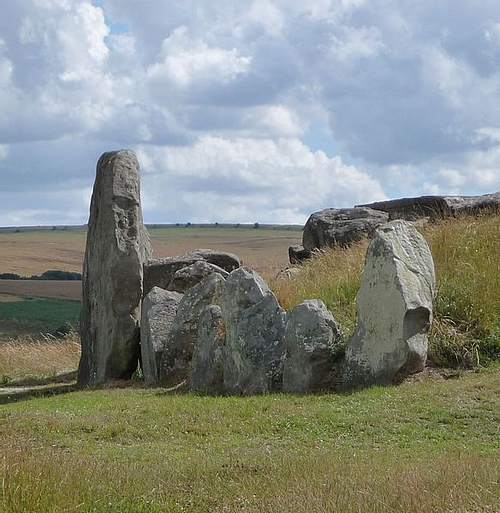
West Kennet Long Barrow
West Kennet, is one of the best-known examples of a Neolithic long barrow in Britain. This burial mound is of the Cotswold-Severn type, and is a 100-metres long mound of chalk with flanking ditches on either side. The chamber inside the mound contained the remains of at least 46 individuals in various states of disarticulation. At this site there is also evidence to suggest that some of the bones had been removed from the chamber, a possible reason being for the circulation of living family members. Similarly, there is also evidence of stray long bones and skulls, which seem to suggest that these remains may have come from other sites. This evidence seems to show that West Kennet was significantly more than just a communal burial mound, it served as a locus where bodies were deposited until they decomposed and the bones were sorted and circulated. The long barrows of nearby South Street and Beckhampton, on the other hand, may not necessarily have been funerary at all.
What is clear, given the evidence, is that these monuments, regardless of which group they belonged to, were more than just prehistoric cemeteries intended just for the deposition of the dead, but were instead involved in a whole series of ritual practices designed to bring in the whole community.

